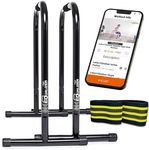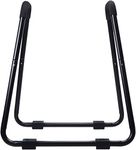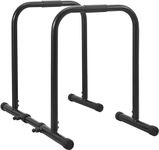Buying Guide for the Best Dip Bars
Choosing the right dip bars is all about matching the equipment to your fitness goals, available space, and comfort preferences. Dip bars are a versatile tool for upper body workouts, especially for exercises like dips, leg raises, and even some push-up variations. When shopping for dip bars, it's important to consider how stable, adjustable, and comfortable they are, as well as how well they fit into your workout area. Understanding the key features will help you make a choice that keeps you safe and motivated.Stability and Build QualityStability refers to how solid and secure the dip bars feel during use, and build quality is about the materials and construction. This is important because unstable or poorly built dip bars can be unsafe and uncomfortable. Dip bars can range from lightweight, portable models to heavy-duty, gym-style equipment. If you plan to do intense workouts or are a heavier user, look for bars with a wide base, thick steel construction, and non-slip feet. For lighter use or portability, a lighter frame may be enough, but always check that it doesn't wobble. Your choice should depend on how intense your workouts will be and whether you need to move or store the bars often.
AdjustabilityAdjustability means whether you can change the height or width of the dip bars. This is important because it allows you to customize the bars to your body size and the exercises you want to do. Some dip bars are fixed, while others let you adjust the height or even the width between the bars. Taller users or those wanting to do exercises like leg raises may need higher bars, while shorter users or those with limited space might prefer lower settings. If multiple people will use the bars, or if you want to do a variety of exercises, adjustable bars offer more flexibility.
Grip ComfortGrip comfort refers to the feel of the handles where your hands go. This is important because uncomfortable grips can cause hand pain or slipping, especially during longer workouts. Some dip bars have foam or rubber padding, while others are just bare metal. If you have sensitive hands or plan to use the bars often, look for padded grips. If you prefer a firmer feel or wear gloves, bare metal might be fine. Think about how long and how often you'll use the bars, and whether you have any grip or hand issues.
Weight CapacityWeight capacity is the maximum user weight the dip bars can safely support. This is crucial for safety, as exceeding the limit can cause the bars to bend or break. Dip bars usually list a weight limit, which can range from around 200 to over 500 pounds. Always choose bars with a weight capacity well above your own body weight, especially if you plan to add extra weight with a vest or belt. Consider your current weight and any future fitness goals when checking this spec.
Portability and StoragePortability and storage refer to how easy it is to move and store the dip bars when not in use. This matters if you have limited space or need to take the bars to different locations. Some dip bars are lightweight and can be folded or disassembled, while others are heavy and designed to stay in one place. If you need to store the bars after each workout or use them in different rooms, look for a compact, foldable design. If you have a dedicated workout space, a larger, more permanent set may be better.



















